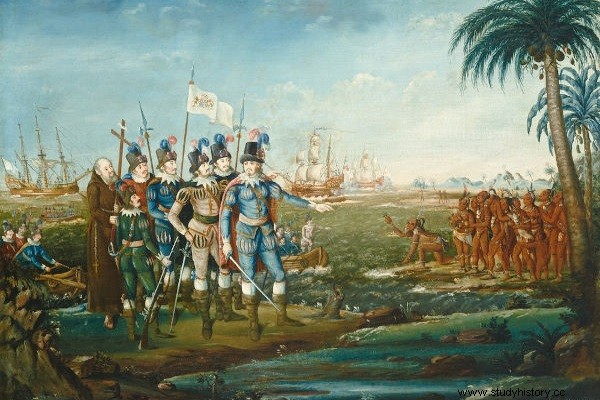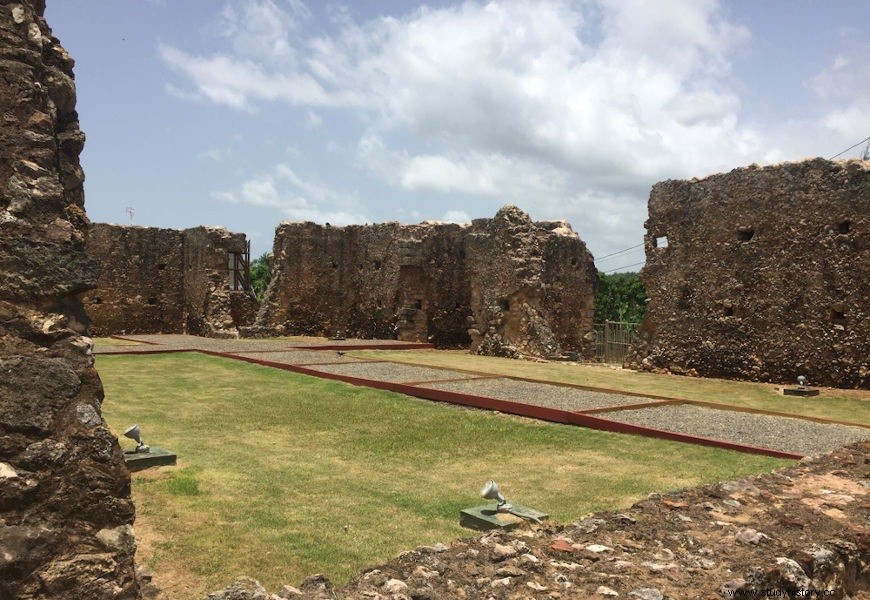The discovery of America happened with the arrival of the Spaniards on the continent, on October 12, 1492, during the expedition of Christopher Columbus . There is a debate among historians about the use of the term “discovery”.>The arrival of the Spaniards in America is related to the great voyages and the search by Europeans to reach the Indian market in order to buy precious spices, very valuable products in Europe. On the side of the indigenous peoples, the arrival of Europeans meant tragedy, as in a few decades millions of them died.
Login also :How did the Spaniards conquer America from the native peoples?
Ocean Exploration
The world , in the European vision of the 15th century , it was small and limited to Europe , parts of the Asian continent and North Africa. This conception changed as the Atlantic Ocean was explored throughout this century. The Atlantic exploration became known as the great navigations.
Through these navigations, significant advances have taken place. First, a vessel suitable for maritime navigation was developed (the caravel ), and new techniques were used to support this activity. The result was that new locations began to be reached, and the mysteries of the ocean, in part, unraveled.
However, this oceanic exploration did not have the purpose of exploration itself or the search for the expansion of geographic knowledge. It had a more pragmatic goal:the profit seeking . The closing of the eastern routes that passed through Constantinople led Europeans to invest in means to reach the East by another way.
In addition, there was a severe shortage of precious metals in some places in Europe, such as Portugal. Thus, exploring the ocean looking for places to obtain this wealth was another factor of great weight. Finally, the expansion of the Christian faith, by other parts of the world, it was also an important motivator for the great navigations.
These factors led the Portuguese to explore the Atlantic Ocean, leading to the conquest of Ceuta , in 1419, as starting point . Portugal's pioneering spirit is explained by the fact that the country met the necessary conditions that allowed it to embark on this undertaking. Spain, on the other hand, did not have the political or territorial conditions for this, and participated in this endeavor belatedly.
It was only after Spain was consolidated during the reign of the Catholic kings (Isabel of Castile and Fernando of Aragon) and that the Moors were expelled from the Iberian Peninsula , in 1492, that the Spaniards decided to invest in maritime navigation. For that, they had a Genoese man who had been asking for funding for a risky trip for years.
Christopher Columbus
The navigator Christopher Columbus, born in Genoa in 1451, had been looking for financiers for his expedition since the early 1480s. Through his reading, Columbus became an advocate of the idea of the sphericity of the Earth . Therefore, he knew that it would be possible to reach Asia by sailing west.
Columbus and his travel plans had been rejected by the kings of Portugal and England. He had also maintained contacts with the French Crown, which did not advance. He still looked for the Spanish kings to finance him, but, because of the war against the Moors, he received a negative answer. It wasn't until 1492, after the Moors were defeated, that the Spanish kings were convinced to finance their expedition.
Login also :Iberian Union - the period when Portugal and Spain were unified in one country
-
Columbus Expedition
The ratification of the agreement between Columbus and Spain took place on April 17, 1492, through the signing of the Capitulations of Santa Fe , the existing contract between the two parties. Columbus received the promises of gain he required and money to assemble three vessels, the caravels Niña and Paint and the ship Santa Maria .

The purpose of the expedition was clear:to reach the Asian continent, first to Japan (called Cipango at the time) and then to India. Columbus hoped to make this crossing in a reasonably short time and managed to convince his sailors of it. This explorer's opinion came about through incorrect estimates made by him about the size of the Earth and the extent of the Atlantic .
On August 3, Columbus' expedition departed Palos de la Frontera in the direction of the Canary Islands, and from there it proceeded westward. The voyage, as mentioned, exceeded Columbus's estimates, so he kept false records of the distances traveled . The purpose of this was to keep his crew calm about the delay in finding new lands.
Even using this tactic, Columbus had problems with the sailors because the voyage was taking too long. This fear was natural, because the longer the voyage, the smaller the resources available on the three vessels. Fears aside, we know that on October 12, 1492, Columbus' expedition reached Guanahani , an island that is part of the Bahamas.
During the trip, there was a bonus for the one who saw land first, and the first to do so was the sailor Rodrigo de Triana , but Columbus claimed he had seen lights the day before (October 11) and took the bounty for himself. When they arrived, what Columbus and the Spaniards saw were naked people (the natives), and this was very different from what the expedition leader had expected.
Columbus believed he had arrived in Asia, and the sight of naked people was something entirely different from what medieval and Renaissance accounts of Asians claimed. This was the first clue to the Genoese that he was not in Asia, but he somehow missed it. Upon landing, he renamed Guanahani Island as San Island Savior .
Columbus spent the rest of his life trying to prove that he had arrived in Asia and sought to find evidence of such a feat in the four trips he made to the same destination, but he was unsuccessful. On this first voyage, Columbus believed he had explored islands in East Asia and the Gulf of Thailand region, but claimed he had not set foot on the mainland.
Still on that trip, Columbus was also on the island that today forms Haiti and the Dominican Republic, calling it Hispaniola . There, he had contact with one of the local leaders, the cacique Guacanagari, who received him peacefully and friendly, offering him gifts and helping him when the Santa María ship sank.
Already on that first arrival, Columbus showed his contempt for the natives, kidnapping some of them to take them to Spain and recording that they could be turned into servants of the Spaniards. The natives were even called Indians by Columbus, because he believed he was close to India.
On the island of Hispaniola, Columbus left 39 men and formed the first Spanish settlement in America:Navidad . This settlement was built in what is now Haiti and with the authorization of Guacanagari. The inhabitants who settled in it were massacred after they began to act cruelly towards the natives, according to anthropologist Josefina Oliva de Coll|1| .
Colonization

With the arrival of the Spaniards in America, the colonization. As we know, in the first expedition 39 men were left on Hispaniola, but all were killed and the settlement was destroyed. On Columbus' second voyage, about 1200 men were brought in to begin the colonization of America, and thesettlement of La Isabela was created.
Conflicts between natives and indigenous people intensified at that time because the Spaniards showed great cruelty by kidnapping women from native villages and committing all kinds of violence in the search for gold. Historian Marianne Mahn-Lot suggests that the Spaniards' stance was justified by the fact that they didn't want to do the hard work that survival in America required. So they turned against the natives , stealing their women and enslaving their men|2| .
After a few decades, the result in the Caribbean islands was disastrous . The natives , forced to deliver quantities of gold and to work exhaustively, began to flee and die . Those who fled settled in mountainous regions. Others died of exhaustion, committed suicide, became seriously ill or were killed by Spanish violence. Soon the millions of inhabitants on the Caribbean islands became thousands.
Login also :Hacienda, an important structure of the Spanish American economy
Has America been discovered?
The term “discovery of America” is the object of long-standing controversy among historians who focus on the subject. Throughout much of the 20th century and into the 21st century, extensive discussions were held, and the controversy on the subject does not end. Anyway, some reflections on this are in order.
First, the notion of discovering America developed decades after the arrival of Columbus . It became popular and became one of the main interpretations on the subject. Therefore, we can take as a starting point the fact that the Spaniards and Columbus himself did not see the event as such.
Among historians of the American continent, the idea of discovery is considered Eurocentric , as it puts America in a perspective that it only came into being when Europeans arrived and settled here. The counter-argument to this notion is that the American continent did not need the European presence to exist, because here it already had very well-established populations, with their own way of life.
In general, the idea of discovery is very popular, but historians try to problematize it. Many understand that the arrival of Europeans to America was a invasion, by which the Europeans accomplished the conquest territory, subjugating the natives through war. In addition, there is also the idea that America was not a European discovery, but a invention .
Finally, as a provocation, it is very important when we reflect on this subject. The term discovery makes reference to the arrival of the Spaniards in 1492 as a groundbreaking event, but does not take into account the fact that they were not the first Europeans to arrive here . At the end of the 10th century, the Vikings arrived in North America, but, unlike the Spaniards, did not settle for a long time.
Thus, we can see that the idea of discovery is not related to the arrival itself, but to the permanent establishment, to colonization. Therefore, with this finding, the idea of invasion and conquest of America gains strength, as it is the fixation and the beginning of colonization (and exploitation) that are seen as relevant within this context.
Notes
|1| COLL, Josefina Oliva de. The indigenous resistance . Porto Alegre:L&PM, 1974, p. 18.
|2| MAHN-LOTT, Marianne. The Conquest of Spanish America . Campinas:Papirus, 1990, p. 28.
